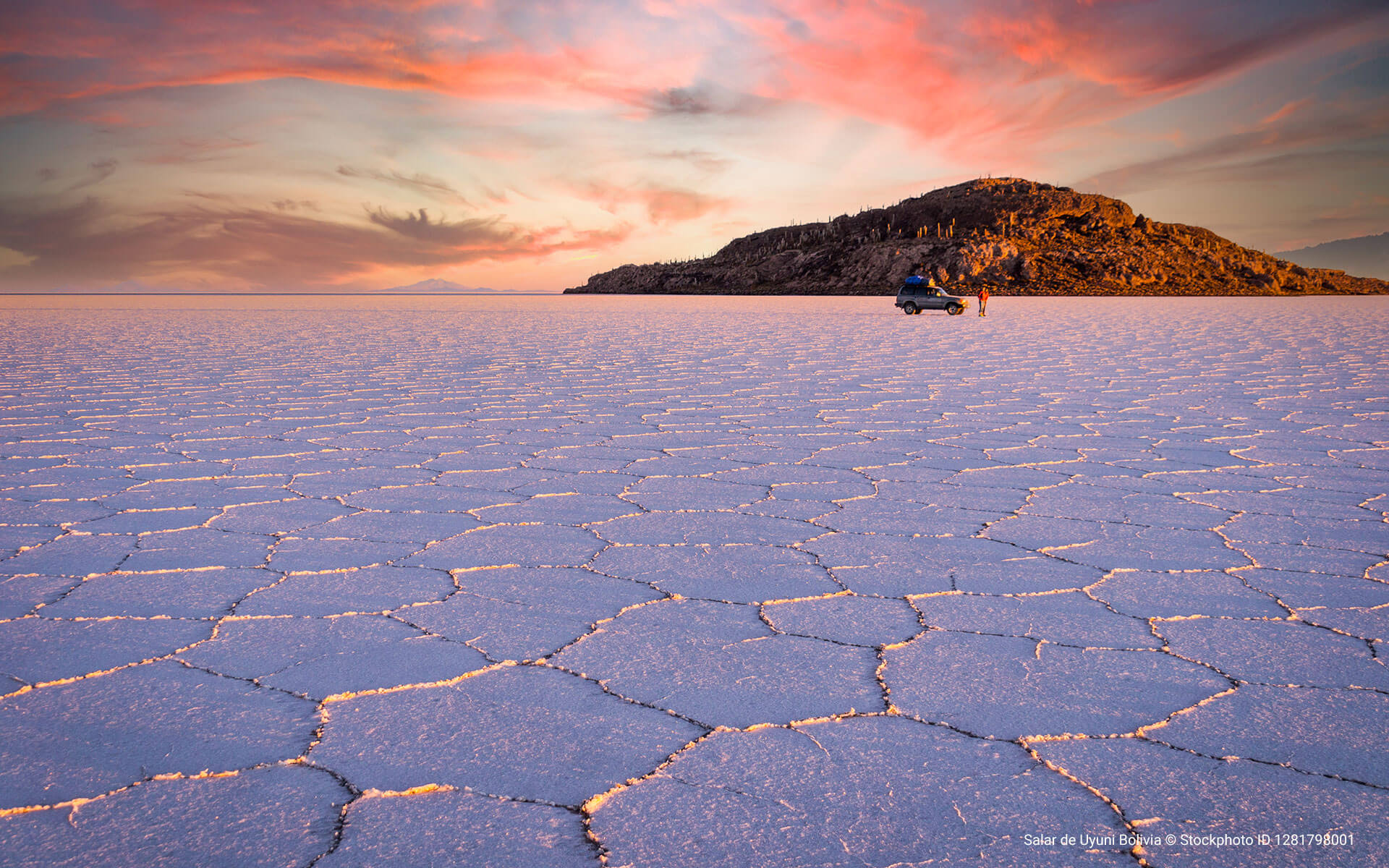
- On 17/02/2024
- In Blogs Travel Tips
- Tags:
Salar de Uyuni
Salar de Uyuni, Bolivia 🇧🇴 The world's largest salt flat in southwest Bolivia. The site is most famous for its mirror effect, when in the rainy season it is transformed into a shallow lake that perfectly reflects the sky all the way to the horizon.
Resources: AmazingPlaces.com | SalardeUyuni.com | Wikipedia | UyuniAdventure.com
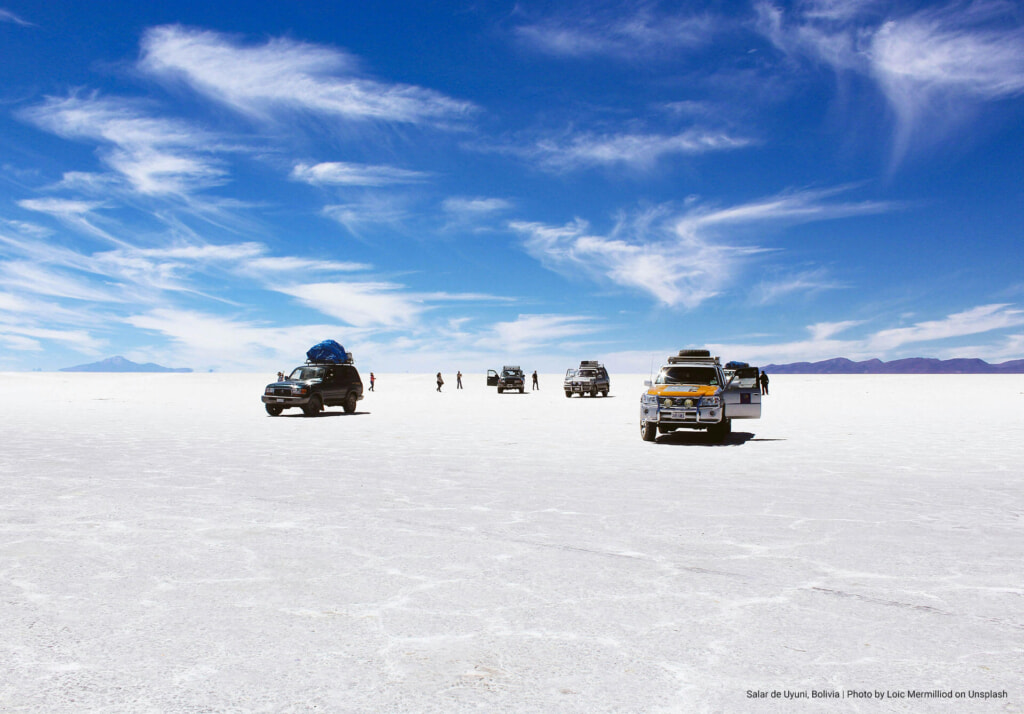
Salar de Uyuni, or Salar de Tunupa is the world's largest salt flat, or playa, at over 10,000 square kilometres in area. It is in the Daniel Campos Province in Potosí in southwest Bolivia, near the crest of the Andes at an elevation of 3,656 m above sea level.
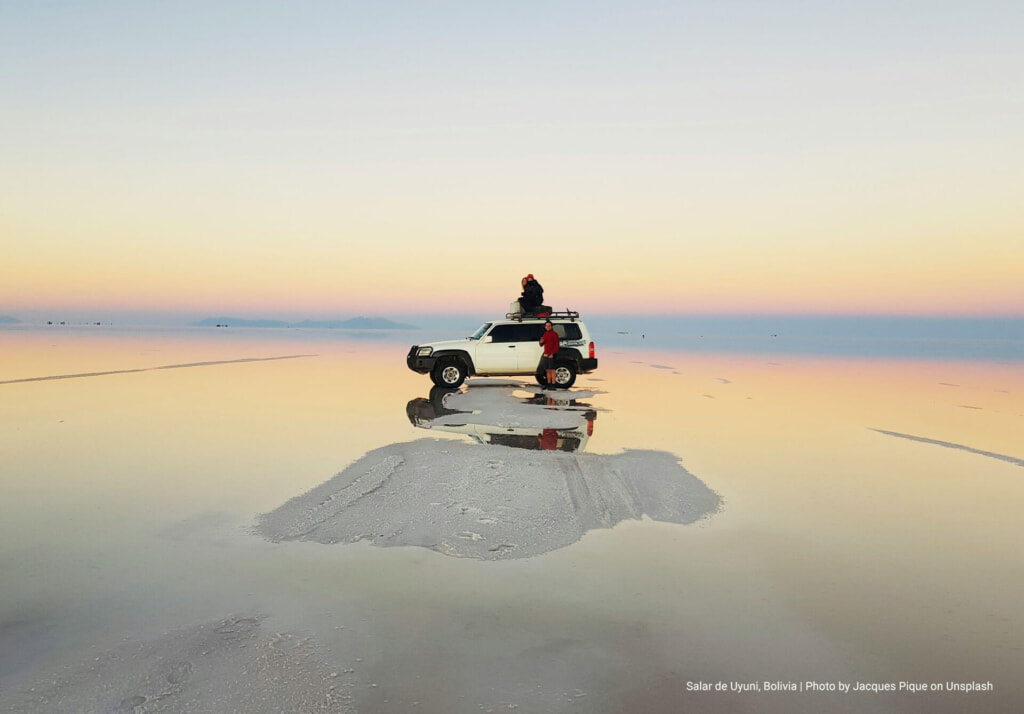
Salar de Uyuni is in quite a remote location, near both the Bolivia-Chile border and the Bolivia-Argentina border. Below are the ways to get there that are most popular among visitors. The length and logistics of your trip will depend on where you’re coming from and where you intend to go afterwards. Consider all of the options below when planning your trip to Salar de Uyuni and pick the one most suitable to your travel plans: from Peru, from Bolivia, from Chile and from Argentina.
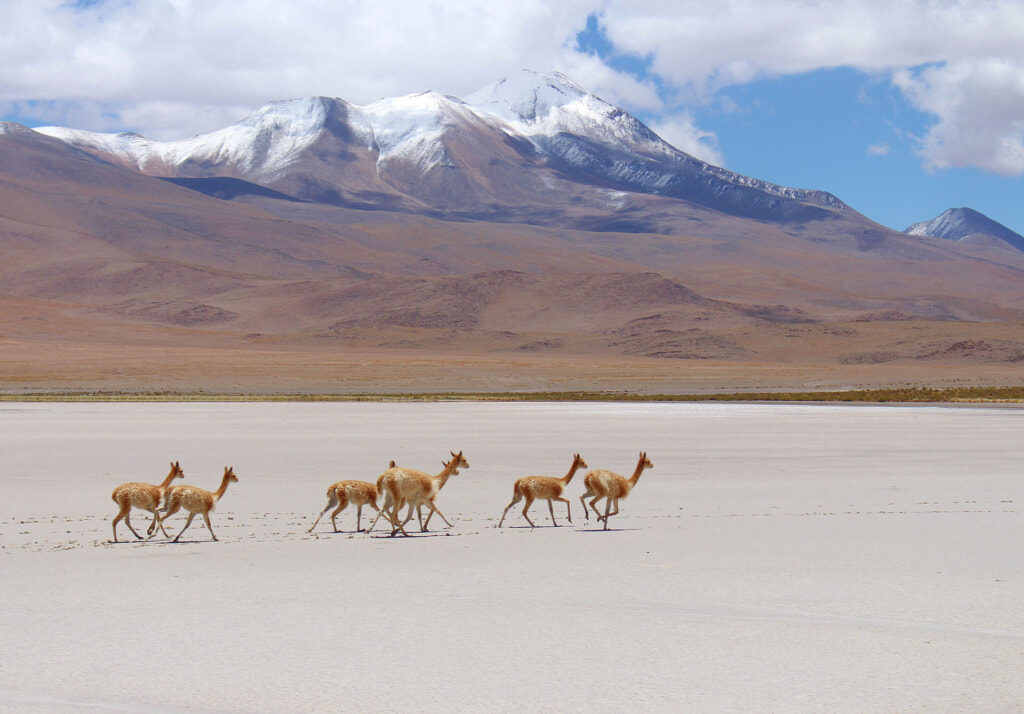
Formation, geology and climate
Salar de Uyuni is part of the Altiplano of Bolivia in South America. The Altiplano is a high plateau, which was formed during uplift of the Andes mountains. The plateau includes fresh and saltwater lakes as well as salt flats and is surrounded by mountains with no drainage outlets. Lacustrine mud that is interbedded with salt and saturated with brine underlies the surface of Salar de Uyuni. The brine is a saturated solution of sodium chloride, lithium chloride, and magnesium chloride in water. It is covered with a solid salt crust varying in thickness between tens of centimeters and a few meters. The center of the Salar contains a few islands, which are the remains of the tops of ancient volcanoes submerged during the era of Lake Minchin. They include unusual and fragile coral-like structures and deposits that often consist of fossils and algae.
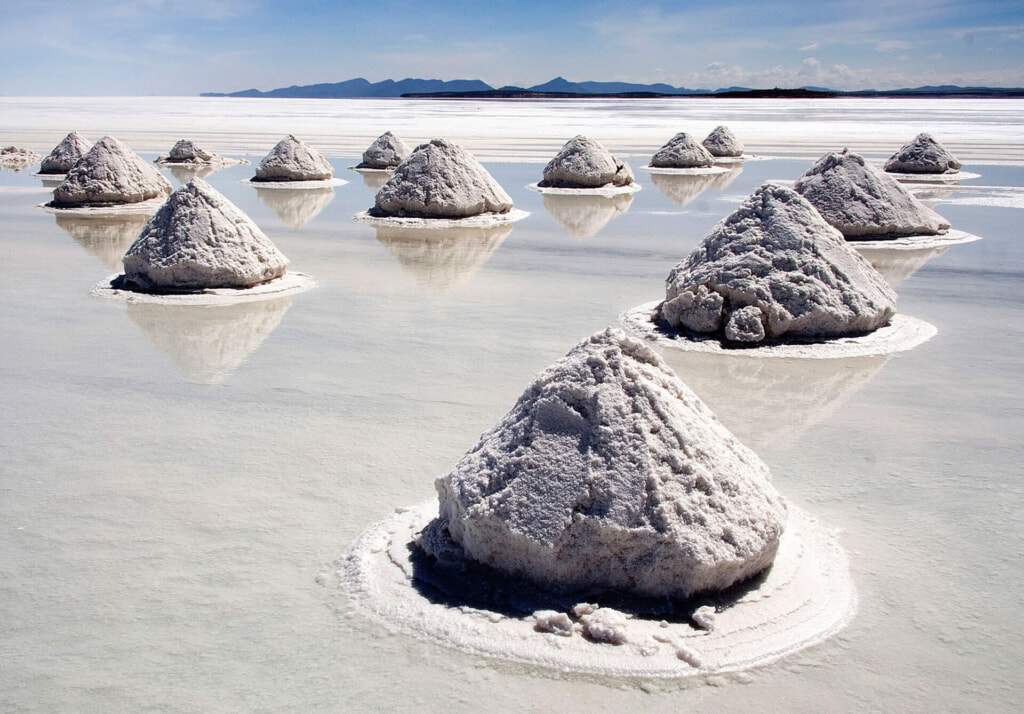
Economic influence
Salar de Uyuni is estimated to contain 10 billion tonnes of salt, of which less than 25,000 tonnes are extracted annually. All miners working in the Salar belong to Colchani's cooperative. Because of its location, large area, and flatness, the Salar is a major car transport route across the Bolivian Altiplano, except when seasonally covered with water.
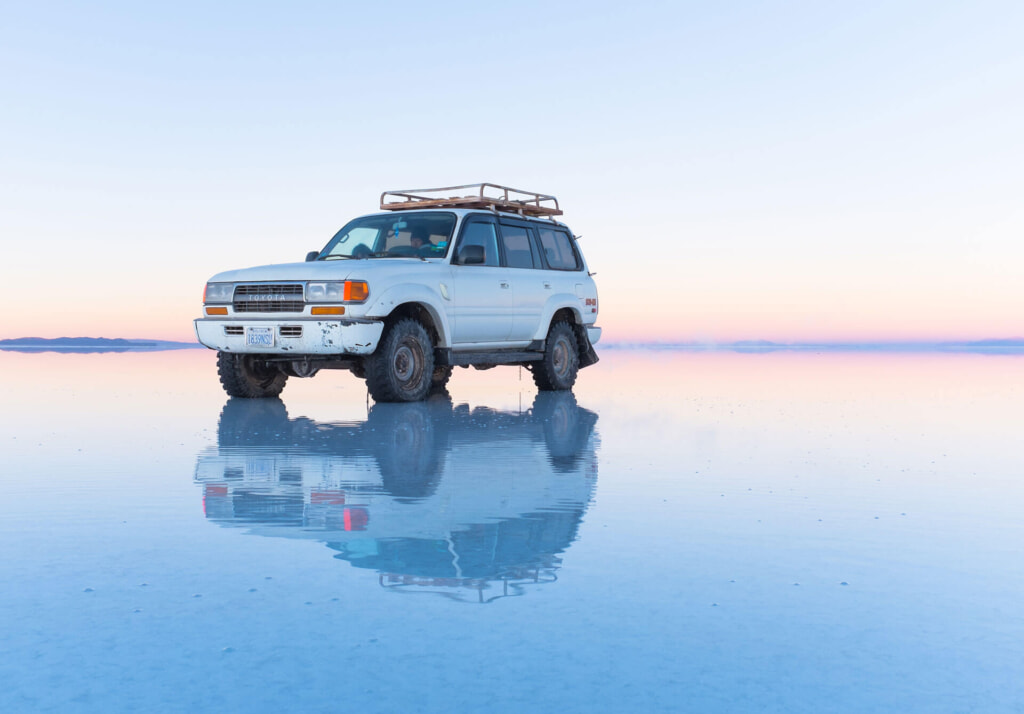
The Name
Salar means salt flat in Spanish. Uyuni originates from the Aymara language and means a pen; Uyuni is a surname and the name of a town that serves as a gateway for tourists visiting the Salar. Thus Salar de Uyuni can be loosely translated as a salt flat with enclosures, the latter possibly referring to the islands of the Salar. Aymara legend tells that the mountains Tunupa, Kusku, and Kusina, which surround the Salar, were giant people. Tunupa married Kusku, but Kusku ran away from her with Kusina. Grieving Tunupa started to cry while breastfeeding her son. Her tears mixed with milk and formed the Salar. Many locals consider the Tunupa an important deity and say that the place should be called Salar de Tunupa rather than Salar de Uyuni.
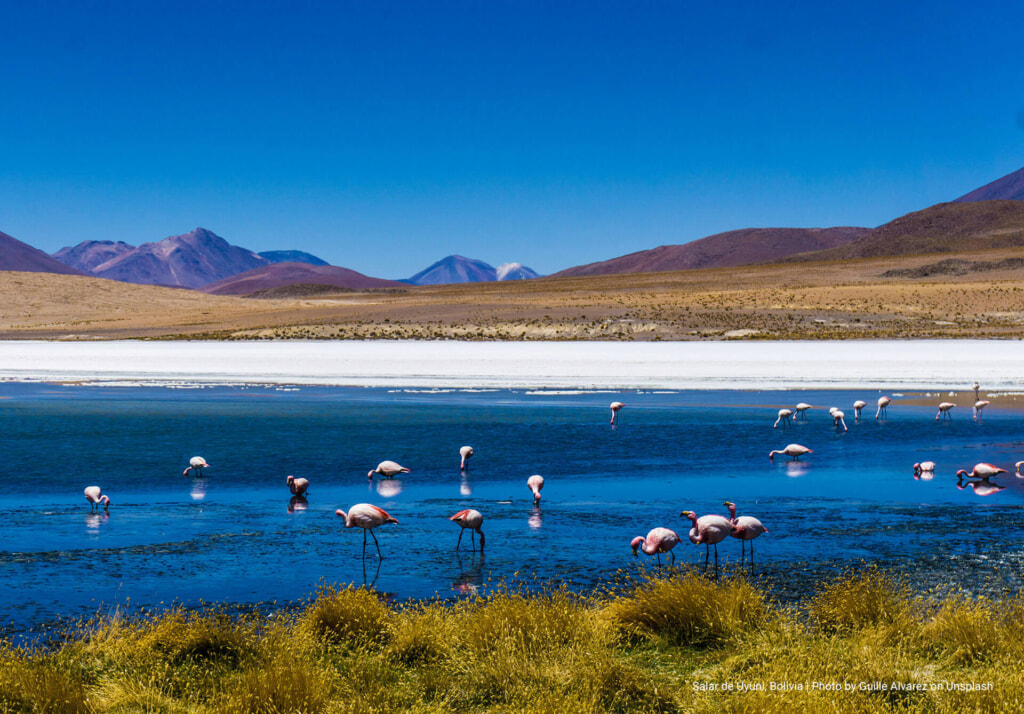
Flora and fauna
The Salar is virtually devoid of any wildlife or vegetation. The latter is dominated by giant cacti: Echinopsis atacamensis pasacana, Echinopsis tarijensis... Every November, Salar de Uyuni is the breeding ground for three South American species of flamingo feeding on local brine shrimps: the Chilean, Andean, and rare James's flamingos. About 80 other bird species are present, including the horned coot, Andean goose, and Andean hillstar. The Andean fox, or culpeo, is also present, and islands in the Salar host colonies of rabbit-like viscachas.
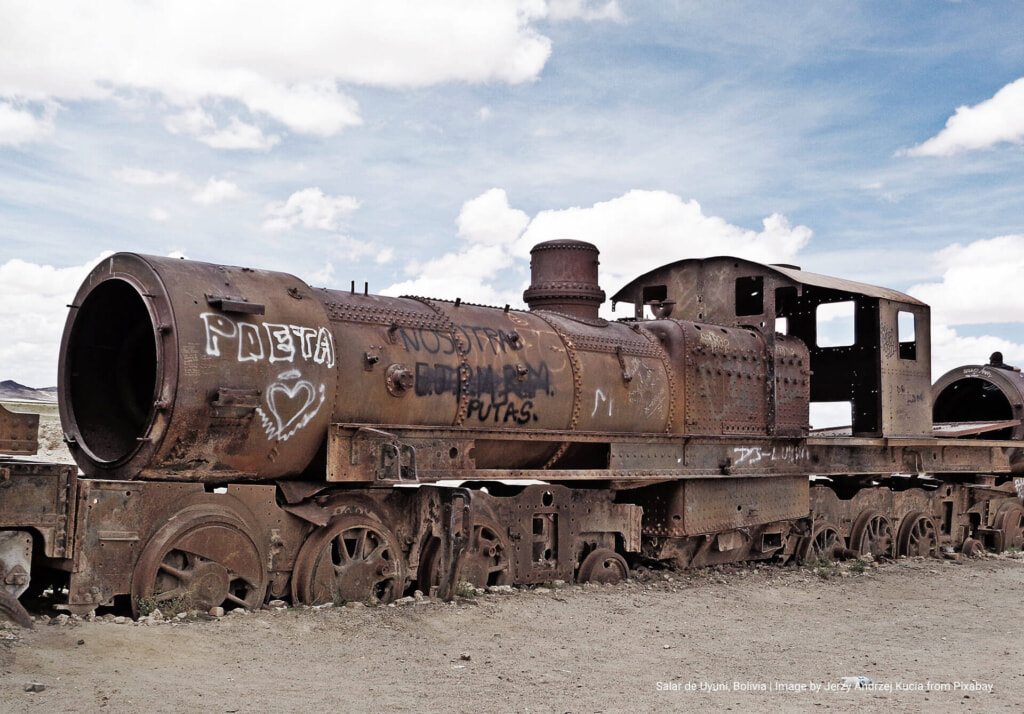
Cementerio de Trenes
Cementerio de Trenes, or train cemetery, is a strange attraction. Countless trains are parked in No Man's Land. There are several trains just outside the village of Uyuni, just to rust. Most of the trains come from England and date back to the 19th century.Uyuni was once an important hub for trains from Calama in Chile, La Paz, Potosí and Villazon on the Argentinian border, among others. But the glory days are over. As a result, countless carriages, but also locomotives, were given a final resting place in Uyuni. It is an impressive setting, and a great place to take pictures, especially in the early morning or late afternoon.
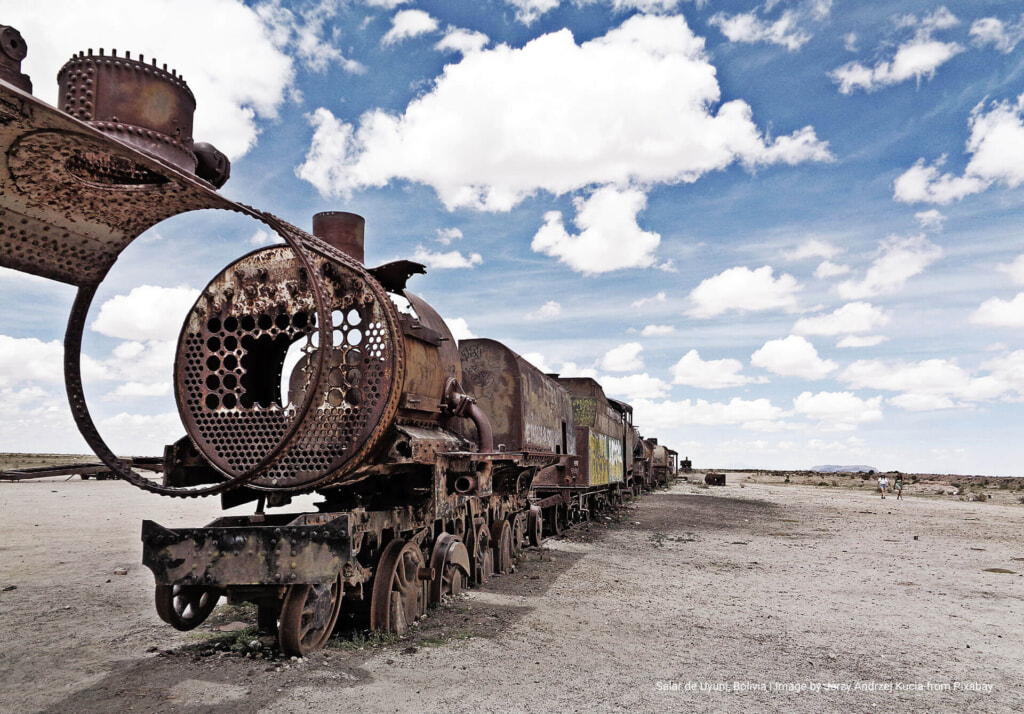
Satellite calibration
Salt flats are ideal for calibrating the distance measurement equipment of satellites because they are large, stable surfaces with strong reflection, similar to that of ice sheets. As the largest salt flat on Earth, Salar de Uyuni is especially suitable for this purpose. In the low-rain period from April to November, due to the absence of industry and its high elevation, the skies above Salar de Uyuni are very clear, and the air is dry. Using Salar de Uyuni as the target, ICESat has already achieved the short-term elevation measurement accuracy of below 2 centimeters.
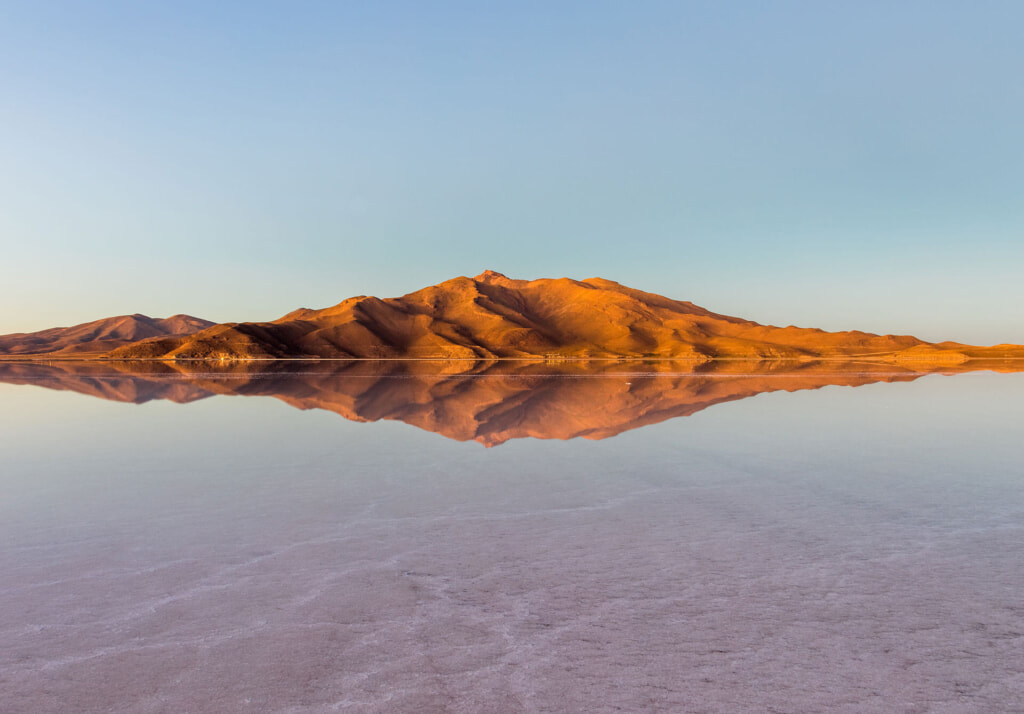
Experience Bolivia's Salar de Uyuni
Salar de Uyuni is a unique salt flat in Bolivia. It is huge, but above all beautiful. You can experience it relatively easily; in a group or individually. This is done with a jeep or other four-wheel drive vehicle. Although you can also drive there yourself with your rental car. These are the best tips and all the attractions so that you get the most out of your trip. Most people visit Uyuni for the immense salt flat, but you will be amazed at the volcanoes and bubbling mud pools. And a wonderful graveyard of trains. So take the time for your visit. It would be a shame to travel to Uyuni and not have enough time for all the sights.
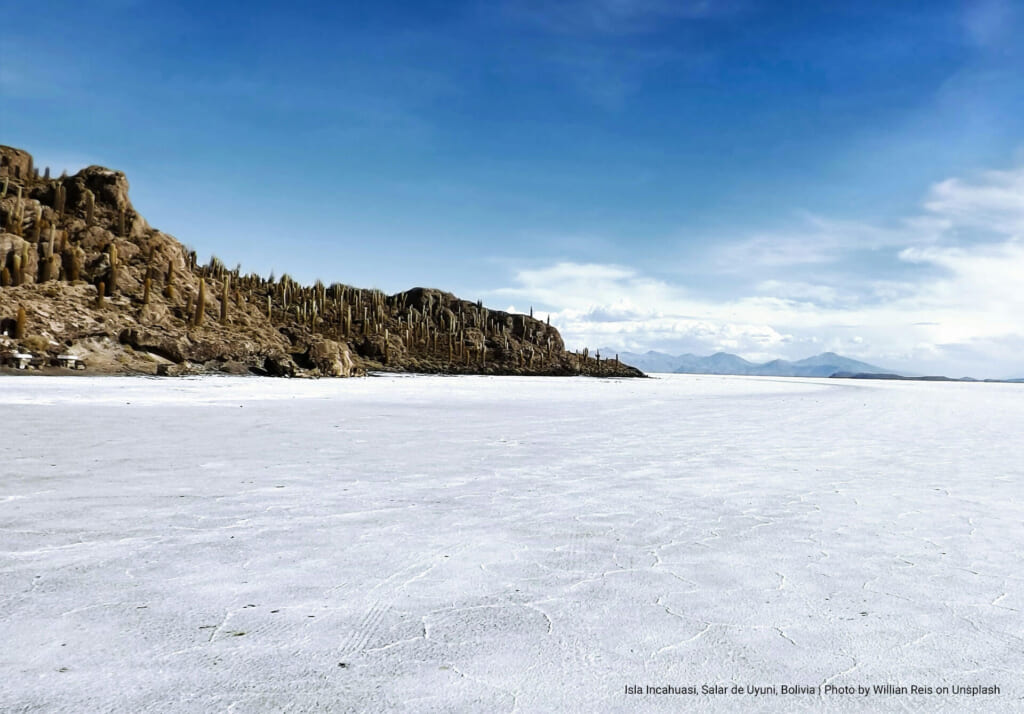
Isla Incahuasi
The famous Isla Incahuasi, is also called Cactus Island or Isla del Pescado. The last name is because the island has the shape of a fish. It is one of the islands that rise above the Salar de Uyuni. Isla Incahuasi is not really high, about 102 meters. On this island you have a good view over the salt flat, but you can also see the cactus species Trichocereus pasacana. They grow to more than ten meters in height. It is also famous for the many fossils including algae that you can see. Which shows that this used to be a gigantic sea, although it is difficult to imagine now.
Ojos de Sal
Ojos de Sal represents a strange phenomenon. In some places cold water bubbles up from under the salt flat. Ojos means eyes, because the water makes holes in the salt that look like eyes. The salt crystals are, according to scientists, the purest of all. Razor-sharp and as smooth as a mirror. Ojos de Sal is located on the Salar de Uyuni, ask for the location on the spot.
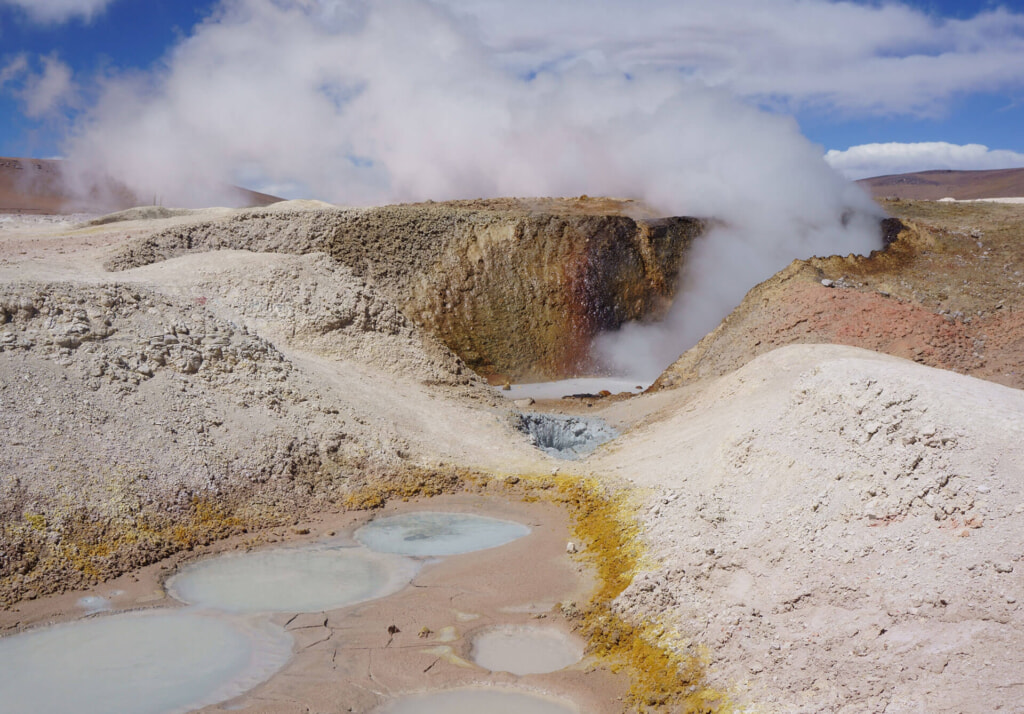
Sol de Mañana
The wonderful Sol de Mañana is a geyser area of about 2 sqkm. According to the locals, it is located at an altitude of 4,850 meters. You can see gases inject mud about three meters above the ground. Remarkably, El Tatio's famous geysers are located in Chile's Atacama Desert on the other side of the mountain. But El Tatio is an immense geyser field, while Sol de Mañana has only a few geysers but many bubbling mud pools. The best time to see these geysers is early in the morning when the most productivity can be seen. The first rays of the sun provide more steam, which decreases during the day. Don't forget to look at the hills. The sun beautifully illuminates the entire area.
City of Uyuni
For many, the city of Uyuni is the starting point for an exploration of the salt plains. The town was founded in 1890 as a trading town. The village is at an altitude of 3,670 meters. Uyuni is also famous for its street market, although it has become a lot more popular in recent years. It is now much more tourist-oriented, as you will soon see. You can find numerous hotels and hostels. It's also possible to book various excursions for your trip.
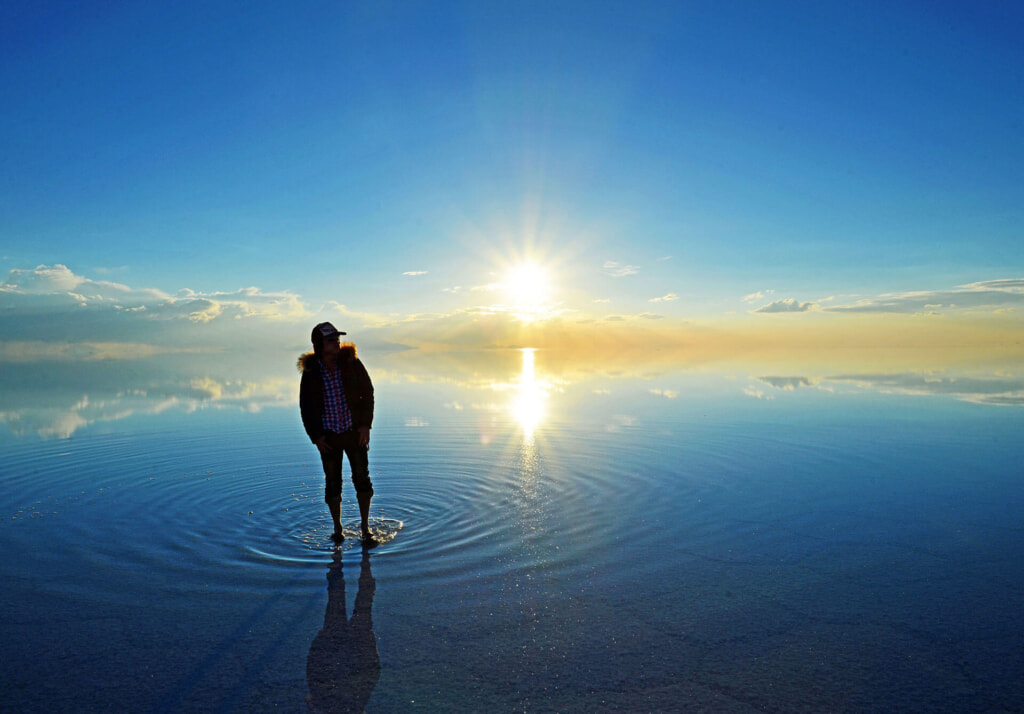
Other attractions:
Mount Tunupa, Coquesa, Vally of the Rocks, Lake Poopó, Salar de Coipasa, Colchani, See Flamingos, Swim at Termas de Polques, Visit the salt factory...
The Salar de Uyuni is a natural wonder of the world that you won't want to miss. Explore the Uyuni salt flats and discover the natural beauty of Bolivia 🇧🇴
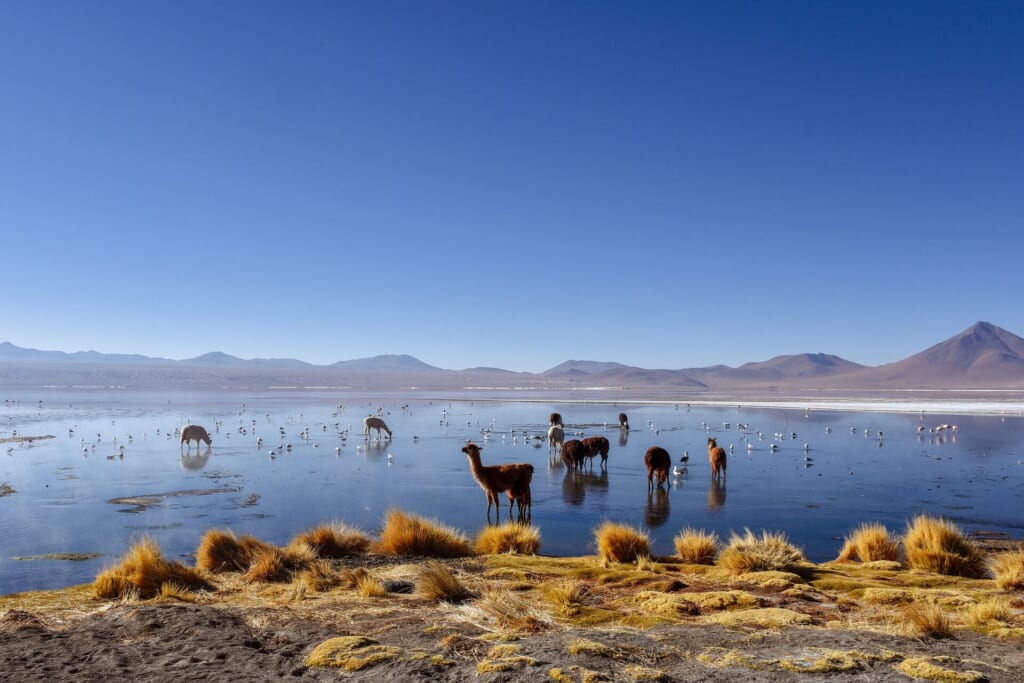
Thiên Xuân Travel – Live your travel dreams!
Park 2, 208 Nguyen Huu Canh Street, Ward 22,
Binh Thanh District, Ho Chi Minh City, Vietnam
📨 booking@thienxuantravel.com
☎️ +84 888 890 898 — 0938 558 228
Office in the United States
14114 Beech Glen Dr, Houston, TX 77083
☎️ +1 (281) 906-2744
Resources: AmazingPlaces.com | SalardeUyuni.com | Wikipedia | UyuniAdventure.com

